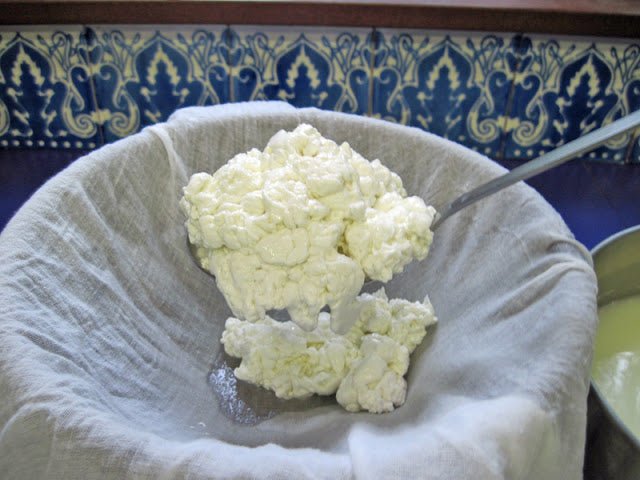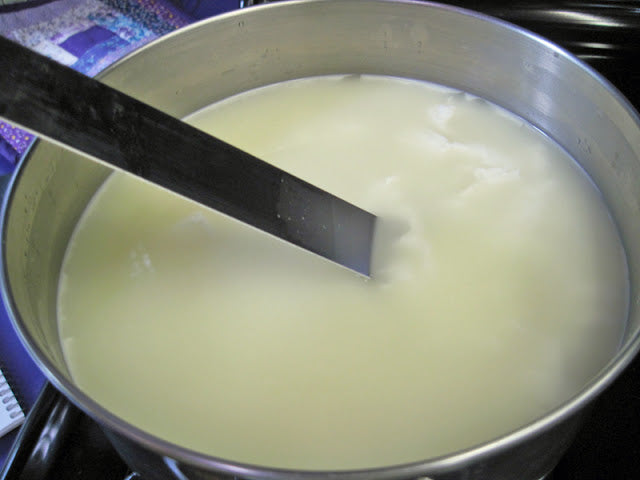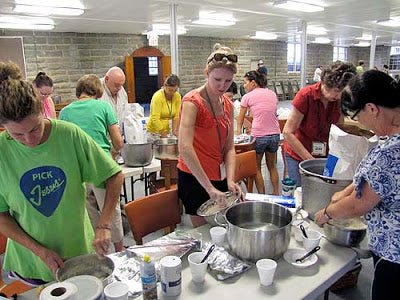 |
| Jeri |
Recipe from Mary Jane Toth’s Goats Produce Too!
This is such a good little book! If you’re interested in exploring more cheese-making techniques, the feta cheese making process offers a wonderful opportunity to experiment with different milk types, including goat’s milk. This can yield unique flavors and textures, making it a delightful addition to your cheese repertoire. I think it’s the perfect way to start making goat’s milk cheese. Mary Jane Toth provides all the information you need in a simple, unpretentious, spiral bound booklet. You set it on your counter and you do what it says!
There are 3 recipes in the book for goat’s milk cottage cheese. One is slower, one is faster and one is very slow but it doesn’t require rennet. I chose the speedy recipe for this article.
Like a lot of her recipes, she calls for using buttermilk as a starter. If you use store-bought, you don’t know how fresh it is and how much culture there is in it. But, if you make your own, you know exactly what you have. So, I made my own, using our buttermilk culture (C21), and here’s how:
1. Making Buttermilk (for the culture)
It really couldn’t be easier. The directions say to use 1 packet per quart of buttermilk. But, I have found that when using fresh milk (in this case it was evening milk from the day before), you can use 1 packet per half gallon.
To prepare, I cleaned and dried the yogotherm, so it would be ready when I needed it.
I heated the milk to 86F.
Then I added the packet of buttermilk culture and stirred for a minute.
Now, I poured it into a yogotherm (you can use any kind of container that you can keep warm.)
I find, in the summer, the warmest spot in the house is on top of the fridge. So, I simply put it there. In the winter, I put it next to a radiator, unless company is coming and I don’t want yogotherms on the floor! (It really doesn’t matter where you put it because it’s insulated.)
If you don’t have a yogotherm, you can wrap your container in an electric blanket. Some folks use their oven with the pilot light on, but if you do that BE SURE TO PUT A NOTE ON THE OVEN so nobody decides to preheat it for some baking!
2. Making Cottage Cheese
Quick Cottage Cheese
Goats Produce, Too!, page 48, (recipe for printing at end of article)
You will need:
1 gallon whole goat milk
1/2 cup cultured buttermilk
1/4 teaspoon liquid rennet (Note: you can always use tablets or powdered rennet instead)
1/4 cup cool water
I warmed the milk to 86F.
I stirred 1/2 cup of buttermilk into the milk.
I mixed 1/4 teaspoon of rennet into a small amount of seltzer water (this was a tip one of our customers sent in to our Moosletter and I have been doing it ever since. It’s especially effective when dissolving rennet tablets. However, I just do it because I usually have cold seltzer around.)
I stirred the rennet for about 20 seconds, slowly in an up and down motion.
Then I put the cover on the pot and left it for 1 hour. (Note: this works with a gas stove, but with an electric stove, you need to remove the pot from the burner because it cools down slowly.)
It was time to cut the curds, but mine were a little too thick. I did my best, but even as I was cutting, I could feel them toughening up. My milk was very fresh and my starter was, too. The next time I make it, I will probably use half as much buttermilk (another advantage to making your own) and I will check the curds after 30 minutes.
I heated the pot to 110F as I stirred, and the curds immediately went to the finished texture.
I spooned them into a colander lined with butter muslin, but there was hardly any draining to be done. The curds were exactly right.
I quickly dipped the curds into cold water (this helps them remain sweet rather than continuing to sour).
And that was it. I added salt. If company was coming, I would probably add a little cream to the curds, but since I’m watching my calories, I didn’t. I like to add this kind of cottage cheese to my scrambled eggs and to salads – even chicken salad.
This cottage cheese qualifies as “raw” because the highest temp was 110F, so it has those good enzymes and probiotic bacteria in it. What better way to start the cold & flu season?
Recipe for printing from Goats Produce, Too!, page 48:
1 gallon whole goat milk
1/2 cup cultured buttermilk
1/4 teaspoon liquid rennet (Note: you can always use tablets or powdered rennet instead)
1/4 cup cool water
Warm the milk to 86F. Stir in the buttermilk. Mix the rennet into the cool water and add to the warmed milk. Let set until it coagulates, about 1 hour. Cut the curds into 1/2 inch cubes.
Heat slowly in a double boiler, until the temperature reaches 110F. Hold temperature for 30 minutes. Stir often to prevent curds from matting together.
When the curds are firm, place into a cloth lined colander. Let drain, for 20 minutes. Lift the curds in the cheesecloth and dip into a pot of cold water. Drain again until the curd stops dripping. Place curds in a bowl and add salt and cream if desired.

































































































































































